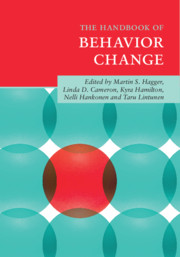Book contents
- The Handbook of Behavior Change
- The Handbook of Behavior Change
- Copyright page
- Dedication
- Contents
- Figures
- Tables
- Sidebars
- Contributors
- 1 Changing Behavior: A Theory- and Evidence-Based Approach
- Part I Theory and Behavior Change
- Part II Methods and Processes of Behavior Change: Intervention Development, Application, and Translation
- Part III Behavior Change Interventions: Practical Guides to Behavior Change
- Index
- References
1 - Changing Behavior: A Theory- and Evidence-Based Approach
Published online by Cambridge University Press: 04 July 2020
- The Handbook of Behavior Change
- The Handbook of Behavior Change
- Copyright page
- Dedication
- Contents
- Figures
- Tables
- Sidebars
- Contributors
- 1 Changing Behavior: A Theory- and Evidence-Based Approach
- Part I Theory and Behavior Change
- Part II Methods and Processes of Behavior Change: Intervention Development, Application, and Translation
- Part III Behavior Change Interventions: Practical Guides to Behavior Change
- Index
- References
Summary
Social problems in many domains, including health, education, social relationships, and the workplace, have their origins in human behavior. The documented links between behavior and social problems have sparked interest in governments and organizations to develop effective interventions to promote behavior change. The Handbook of Behavior Change provides comprehensive coverage of contemporary theory, research, and practice on behavior change. The handbook incorporates theory- and evidence-based approaches to behavior change with chapters from leading theorists, researchers, and practitioners from multiple disciplines, including psychology, sociology, behavioral science, economics, and implementation science. Chapters are organized into three parts: (1) Theory and Behavior Change; (2) Methods and Processes of Behavior Change: Intervention Development, Application, and Translation; and (3) Behavior Change Interventions: Practical Guides to Behavior Change. This chapter provides an overview of the theory- and evidence-based approaches of the handbook, introduces the content of the handbook, and provides suggestions on how the handbook may be used by different readers. The handbook aims to provide all interested in behavior change, including researchers and students, practitioners, and policy makers, with up-to-date knowledge on behavior change and guidance on how to develop effective interventions to change behavior in different populations and contexts.
Keywords
- Type
- Chapter
- Information
- The Handbook of Behavior Change , pp. 1 - 14Publisher: Cambridge University PressPrint publication year: 2020



